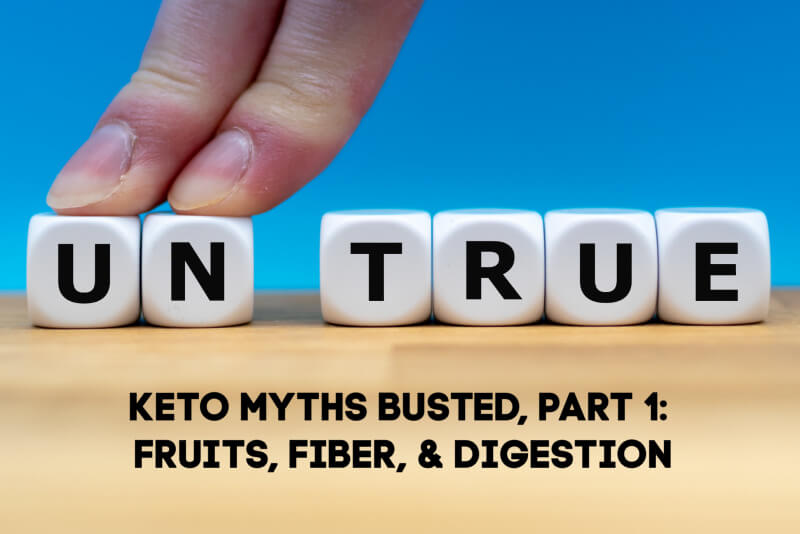Anytime something goes against the status quo, it is bound to draw criticism. Many times, myths are even perpetuated by those who don’t understand.
Keto Zone eating certainly goes against the status quo.
In fact, it goes against what most health experts, universities, and the government have taught for decades. It goes against Western medicine traditions and philosophies.
So, it’s no wonder there are detractors and myths.
And this is okay. A healthy discussion, debate, and unbiased look at the evidence is a good thing.
Unfortunately, many criticisms come without an understanding of keto eating, and without thorough research. Instead, they are often stated based on assumptions of the eating plan and lifestyle.
Thankfully, these myths are easy to bust. Here are 3 Keto Zone Myths, and a thorough explanation that leaves them utterly busted.
3 KetoMyths, Busted. Part 1
Myth #1: Keto Eliminates Most Fruit
This “myth” is actually true.
In fact, it’s not the statement that’s a fallacy. It’s the belief that a diet must contain fruit to be healthy, that’s untrue.
Critics often cite the elimination of fruit as a primary deterrent to Keto Zone eating.
They point to studies that show a reduced risk of cancer, cardiovascular diseases, obesity, osteoporosis, high blood pressure, depression, respiratory diseases, and gastrointestinal diseases. They also list all the wonderful nutrients in fruit.
But here’s what they don’t tell you: Almost all of these studies are of fruits and vegetables, not just fruits. In fact, I am unaware of any study that shows a reduced risk of all of these diseases with fruit consumption compared to vegetable consumption.
Fruits and vegetables share the same benefits including fiber, phytonutrients, antioxidants, magnesium, potassium, folic acid, and vitamins A, E and C. Again, I am unaware of any advantage of fruits over vegetables.
And what they don’t share? High levels of sugars (fructose). Fruits contain about fifteen grams of carbs per serving (~12-13 grams net carbs), while non-starchy vegetables contain about 5 grams of carbs per serving (2-3 grams net carbs).
Anyone following a vegetable-laden healthy Keto Zone eating plan can easily get enough vegetables. And moreover, products like low-carb fermented fruit and vegetable powder offer great options.
Myth #2: Keto is a Low Fiber Diet
Wait, what? I’m not exactly sure from where this myth originates. Maybe, some people believe wheat and other grains are our only fiber sources? Or beans and legumes?
Truly, grains, beans, and legumes offer some benefits such as some fiber. However, the price of these benefits is high-carbs and nutrients that are sometimes poorly-tolerated.
What’s more, foods avoided by Keto Zone eaters, like bread and pasta are not good sources at all, often containing <=2 grams per serving.
On the other hand, there are plenty of keto sources that provide adequate fiber like vegetables, nuts, coconut, and seeds.
In fact, it’s the replacement of grains with nut meal that increases fiber for many people’s diets. And, there’s a lot of motivation to increase fiber in order to reduce net carbs (net carbs = total carbs – fiber).
Again, experts cite that low-fiber diets are associated will all sorts of chronic disease of the gut, cardiovascular disease, heart disease, and diabetes. But, the last time I checked, most Standard American Diet (SAD) eaters consume less than the recommended 20+ grams (1). Clearly, the routine recommendations are not working.
When a Keto Zone eater eats the following daily, they easily consume 20+ grams of fiber:
- 3 servings of vegetables (6-10 grams of fiber)
- ¼ cup nuts or 2 Tbsp nut meal (4 gm fiber)
- 2 tablespoons of seeds such as hempseeds (4 grams fiber)
- 2 tbsp chia seeds per day (8 grams fiber)
How’s that for a reduction in the risk of chronic disease?
Myth #3: Keto Zone Recommends Full-Fat Dairy
Like Myth #1, this myth itself is partly true, but the assumption that it’s unhealthy is false.
First, many keto eaters avoid dairy entirely.
Second, for keto dairy consumers, full-fat dairy is a better choice, according to many studies.
In fact, one study from 2016 that analyzed more than 15,000 mid-aged adults, showed that full-fat dairy, but NOT low-fat, correlated with a reduction in metabolic syndrome (2). Amazingly, the investigators believe it’s the dairy’s saturated fat itself that provide protective benefits.
And another study concluded that low-fat dairy may be responsible for altered glucose metabolism and increasing incidence of Type 2 Diabetes (3).
A third review of over 1500 participants found that full-fat dairy is associated with less obesity (4).
Unfortunately, some experts will claim there is no known benefit or even harm in the consumption of full-fat dairy. These studies and many more seem to suggest to the opposite.
Third, ketosis and its benefits require fats.
Keto Myths Busted, Parts 2-4:
Want to learn about all the myths we’ve busted? Read:
Keto Myths Busted, Part 2: Dietary Fats (Same ol’ anti-fat dogma)
Keto Myths Busted, Part 3: Keto is A Terrible Idea for a Million Reasons (Jillian Michaels’ Myths)
Keto Myths Busted, Part 4: Energy, Fatigue, and Athletes
Bottom Line
In Keto Myths Busted, Part 1, we easily dismantled 3 myths about keto zone eating.
- You can get all the benefits of fruits and vegetables, with only vegetables.
- Keto Zone eaters can easily consume 20+ grams of fiber per day and have a huge incentive in doing so to control net carbs and replace grains in baking.
- Full-fat dairy is likely a better choice for health than low-fat daily.
There’s still more Keto Myths to bust. We’ll keep providing the truth about keto and its benefits, and busting any myths we see.

Leave a Reply